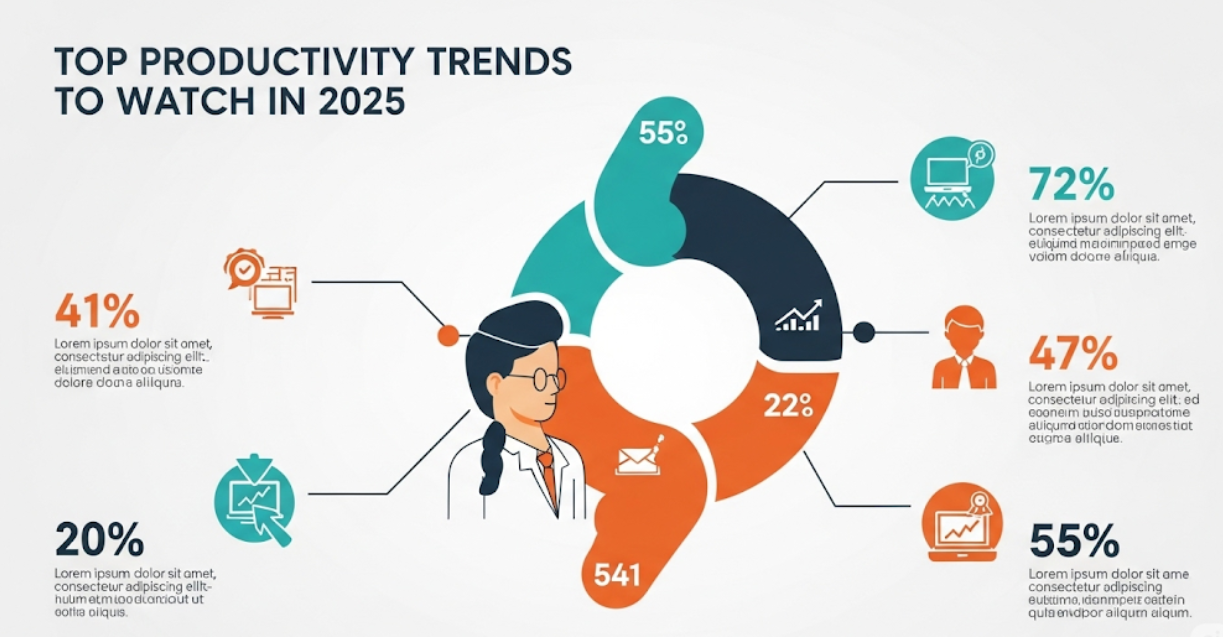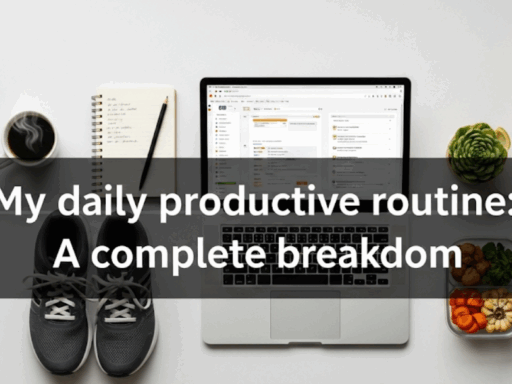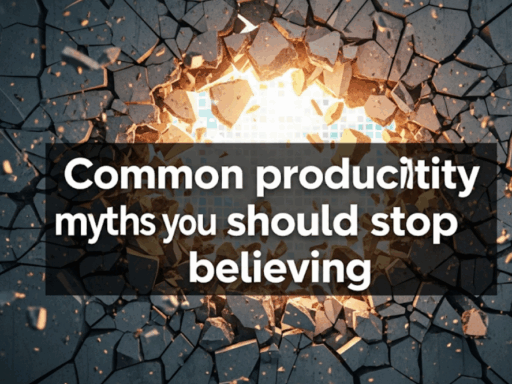Meta Description: “Discover the top productivity trends transforming work in 2025. From AI-powered assistants and hybrid work models to energy management and sustainable systems. Learn how to work smarter with digital wellness, attention management, and collaborative tools that boost efficiency without burnout. Transform your productivity today.”
Biggest Productivity Trends 2025
The workplace is changing faster than ever. We are already seeing the start of the next phase in 2025, with new tools and methodologies for work and the way of working to get things done. Learning to work around and with people who have mastered these trends saves you from being overwhelmed and helps prepare you for what will then be considered normal productivity.
2025 has a lot to offer in terms of artificial intelligence, workplace flexibility, and digital wellness—all clearly marked as key ingredients in how we achieve our work as well as personal aspirations. 2025 is laying the groundwork for an explosion in productivity that ranges from AI-powered assistants that will finally understand what you want to methods of keeping focused during our always-connected lives.
Here are the top trends that will define how we work, learn, and meet our goals in 2025.
First Up: AI-Powered Personal Assistants
Artificial intelligence, once just a buzzword, is now quickly turning into your new work partner. AI assistants have grown exceedingly wise, very personal, and impressively good for your productivity in 2025.
The Key to Getting Things Done Right with Smart Task Management
No longer is this a simple to-do list. Today’s AI assistants can:
- Predict your priorities based on your work patterns and deadlines
- Auto-schedule tasks at the most productive time
- Deconstruct complicated projects into bite-sized tasks
- Provide smart reminders, not just random push notifications
This method learns from you as a person. For instance, they recommend organizing most writing assignments before noontime if you are at your peak creativity times in the morning. They will come up with more efficient ways of doing that type of work or they will split them into tons of smaller pieces.
Voice-First Productivity Tools
We’re getting better at talking to our devices. Modern voice assistants can:
- Focus on conversation while taking very specific notes during meetings
- Schedule events with extensive logic requirements on the calendar
- Perform natural language file searches
- Write emails that sound like you wrote them
The big thing that changes in 2025 here is how well these tools understand context. You can tell it you want to, for example, “reschedule my afternoon meetings because the Johnson project is running behind,” and it will know what that means.
Personalized Workflow Automation
AI is rapidly getting proficient at watching how you work and helping with improvements. These smart systems can:
| Feature | Use Case Example |
|---|---|
| Pattern Recognition | Alerts you when it recognizes a pattern that focuses on the important, interrupts what can wait |
| Smart Notifications | Gives alerts for urgent notifications at work only between 10am–6pm |
| Automated Reporting | Generates reports of your work with daily status updates of activities |
| Task Batching | Groups same kinds of activities together, schedules all phone calls for Tuesday afternoons |
Hybrid Work Models That Actually Work
We are not going back from hybrid work, but by 2025, we will have finally learned how to do it well. Organizations and employees around the world are realizing that a thriving hybrid work environment will depend on defined strategy and enabling technology.
The Three-Day Office Rule
Some companies are opting for a “3 in and 2 out” scheme, though the most brilliant organizations leave it to teams to determine which three days make sense for their projects. This flexibility allows for:
- Tuesdays: Collaboration days, so the entire team works together on brainstorming or other collaborative projects
- Fridays: Deep work days where everyone works from home separately to concentrate on individual pieces of their projects
- Mondays: Flexible as long as attendance is required for your current projects
Digital-First Meeting Culture
Hybrid teams are reimagining meetings altogether. The highest performing organizations are using:
Async-First Communication:
- Decisions get made in docs, not on calls
- Team updates as video recordings instead of status meetings
- Instant messages are used for quick questions, not scheduled calls
Meeting Minimalism:
- Every meeting is planned with clear intent and purpose
- 25 minutes is the default, not 30
- Deep work time is sacred and protected by no-meeting days
Enhanced Virtual Collaboration:
- Digital whiteboards replace physical ones
- Interactive presentations with screen sharing tools
- Small group discussions even in large meetings with breakout rooms
Home Office Optimization
Remote work 2.0 includes the latest trends:
- Dedicated space in the home office
- Circadian lighting systems
- Noise-canceling setups for better focus
- Investing in ergonomics that will protect you from future health problems
Attention Management in the Era of Distraction
Given that notifications are swarming from all directions, managing your attention is a learned skill. 2025 is changing how we focus in a hyper-connected world.
Digital Minimalism Goes Mainstream
The idea of “digital decluttering”—deliberately removing the digital clutter from our lives—is being taken up by more and more people. This includes:
App Auditing:
- Deleting apps that are useless
- Focus modes with hidden distractions
- Scheduling social media and news check times
Notification Mastery:
- Turning off non-essential app notifications
- Using “Do Not Disturb” with work focus
- Setting automatic replies to manage expectations
Screen Time Boundaries:
- Implementing phone-free meals and meetings
- Instituting technology curfews at night
- Engaging in analog activities during downtime
An Improved Take on The Pomodoro Method
The classic 25-minute work session is finally evolving. Modern focus techniques include:
- Adaptive timing to accommodate your preferred work intervals—shorter for creative tasks, longer for focused deep work
- Task-based timing matched with energy levels and the right time of day
- Background music recommendations using binaural beats and focus-enhancing soundscapes
Attention Restoration Practices
Breaks are not just for rest now—they’re also for recovery of attention. Effective techniques include:
Micro-Recovery Sessions:
- 2-minute breathing exercises between tasks
- Walking or stretching for a few minutes every hour
- Gazing at far away objects to relax your eyes
Nature Integration:
- Workspaces with outdoor views
- Plants and natural elements in workspace design
- Taking outdoor breaks whenever possible
Mindfulness Integration:
- Beginning every work period with a brief centering exercise
- Mindful transitions from one task type to another
- Completing the working day with a distinct closing ritual
Health-Conscious Productivity Methods
Productivity and wellness blur together. By 2025, the productivity systems that work are those that align with your physical and mental health, rather than working at their expense.
Energy Management Over Time Management
Smart workers are managing their energy, rather than just managing their schedule. This approach recognizes that:
Different Tasks Require Different Energy Types:
- Creative work needs mental freshness
- Administrative work can be done when energy is low
- Social interactions require emotional energy
- Physical tasks require bodily strength and coordination
Energy Levels Change Throughout the Day:
- Complex problem-solving may be best executed in the morning
- Routine tasks work well during afternoon energy dips
- Planning and reflection fit well in evening hours
Movement-Integrated Work
Sedentary work is getting a redesign. Popular approaches include:
- Walking meetings for screen-free conversations
- Regular movement breaks to keep energy flowing
- Standing desk intervals throughout the day
- Energizing exercise periods instead of energy-draining sessions
Sleep-Productivity Connection
It’s time we start associating a good night’s rest with productivity rather than something that slows us down. Key practices include:
Sleep Schedule Consistency:
- Consistent bedtime and wake-up hours
- Regulating circadian rhythms with light therapy
- Wind-down routines that signal it’s time for sleep
Recovery-Focused Evenings:
- No screens an hour before bedtime
- Stress reduction techniques for particularly stressful days
- Planning the next day to avoid morning anxiety
Nap Strategy:
- Strategic 20-minute power naps during afternoon energy dips
- Weekend recovery without interfering with weekday schedules
Collaborative Tools That Actually Connect Teams
Teamwork is finally becoming work with new tools that make people collaborate more than they communicate. More collaboration, fewer meetings.
Asynchronous Collaboration Platforms
The top teams are becoming incredibly good at working asynchronously. Modern collaboration includes:
Shared Knowledge Bases:
- Company wikis that everyone can contribute to
- Decision logs capturing the how and why of decisions
- Automatically updated project documentation
Collaborative Document Creation:
- Real-time editing that doesn’t require being online simultaneously
- Threaded comments to save discussion points
- Version control so work is never lost
Flexible Communication Channels:
- Project-specific channels that direct conversation
- Voice messages for complex explanations
- Progress updates without meetings
Project Visualization Tools
Everyone benefits from seeing the big picture. Popular approaches include:
- Kanban boards for visualizing work as it moves through stages
- Timeline views to help plan deliverables with deadlines
- Dependency mapping to illustrate how tasks are related
- Progress dashboards to celebrate finished work
Remote Team Building
It takes work to build relationships when there are long distances between team members. Successful remote teams use:
Virtual Coffee Chats:
- Frequent casual non-work conversations
- Team involvement by discussing personal interests and hobbies
- Connecting stakeholders across departments and breaking down silos
Online Team Challenges:
- Fitness challenges via social media
- Learning challenges where team members teach each other skills
- Creative challenges that showcase different talents
Digital Recognition Systems:
- Peer nomination awards for helpfulness and collaboration
- Public celebration of wins
- Visible appreciation through thank-you systems

Data-Driven Self-Improvement
People are turning to data to better understand their own productivity patterns. This isn’t about obsessive tracking but about acquiring insights that result in better decision-making.
Personal Analytics That Matter
Unlike people who track everything, successful people focus only on metrics that improve their performance:
Time Audit Insights:
- The reality of where your time goes vs. what you think
- Identifying which activities are time well spent
- Understanding what your best and worst days have in common
Goal Progress Tracking:
- Breaking big goals into small milestones
- Early obstacle detection
- Celebrating small wins that keep you motivated
Habit Formation Data:
- Success percentage of creating new habits
- Physical and social circumstances that help or hinder consistency
- Optimal timing for changing up routines
Productivity Metrics Dashboard
| Metric Type | What to Track | Why It Matters |
|---|---|---|
| Focus Time | Hours of uninterrupted work | Good indicator of deep work capacity |
| Task Completion | Ratio of completed vs. started tasks | Shows planning effectiveness |
| Energy Patterns | Energy levels during the day | Optimizes task scheduling |
| Communication Load | Time spent on meetings and email | Reveals collaboration overhead |
Feedback Loop Creation
Real self-improvement comes from consistent introspection and adaptation:
Weekly Reviews:
- What worked well this week?
- What could be improved?
- What are next week’s priorities?
Monthly Planning Sessions:
- Are current goals still relevant?
- What skills would be helpful?
- How can systems and processes be improved?
Quarterly Deep Dives:
- High-level patterns spanning several months
- Major goal changes based on learning
- Investment in new tools or training identified as needed
Technology Integration Without Overwhelm
Productivity in 2025 will be less about using every new shiny tool, and more about selecting the tools that work best for you and your team while complementing your existing workflow.
The Minimalist Tech Stack
Productive people have created streamlined technology solutions instead of trying to manage dozens of different apps:
Core Applications:
- One primary task manager
- One note-taking system
- One calendar application
- One main communication platform
Integration Focus:
- Tools that work well together
- Automatic data syncing between applications
- Single sign-on systems to reduce password fatigue
- Cross-platform compatibility for device switching
Automation Without Losing Control
Smart automation takes care of routine tasks but lets you make decisions on matters that really count:
Email Management:
- Automatic sorting of routine messages
- Template responses for common questions
- Scheduled sending to respect time boundaries
- Unsubscribe automation for newsletter cleanup
Calendar Optimization:
- Automatic scheduling of recurring tasks
- Buffer time between meetings
- Travel time calculation for in-person events
- Smart deadline alerts
File Organization:
- Automatic backup of important documents
- Smart folder sorting by project type
- Version control for collaborative documents
- Archival systems for completed projects
Learning New Tools Efficiently
The key is adopting new tools in structured ways that don’t interrupt your existing workflow:
Take It One Feature at a Time:
- Practice with low-stakes work before using in critical situations
- Configure properly with templates and preferences
- Give the tool enough time to become part of natural workflow
Building Sustainable Productivity Systems
The biggest trend emerging in 2025 is the realization that productivity systems should be sustainable long-term. Less focus on quick fixes and productivity hacks; more emphasis on sustainable practices that promote long-term high performance without burnout.
Long-Term Thinking
Sustainable productivity focuses on:
Consistency Over Intensity:
- Doing the right things consistently over time
- Creating a sustainable work pace resistant to burnout
- Building in recovery periods and flexibility
- Adapting to evolving situations
Skill Development Investment:
- Continuous learning that builds skills over time
- Regular practice routines
- Building knowledge systems
- Relationship building for future opportunities
Personal Sustainability Practices
The most productive people in 2025 will adopt:
- Long-term thinking with realistic daily goals
- Energy allocation for what really matters
- Support networks for challenging times
- Celebrating progress along with end goals
System Maintenance
Productivity systems, like any good tool, require periodic upkeep:
Regular System Reviews:
- Monthly check-ups on what’s working and what isn’t
- Seasonal adjustments for changing priorities and schedules
- Annual overhauls incorporating new knowledge and tools
- Continuous improvement based on performance data and feedback
Flexibility and Adaptation:
- Resilience during stressful periods
- Backup systems and contingency plans
- Gradual evolution rather than dramatic overhauls
- Room for experimentation with new approaches
Conclusion: Your Future of Productivity Starts Today
The world of work in 2025 presents a once-in-a-generation opportunity to work smarter, not just harder. These tools and methods are poised to change how you achieve your goals, from AI assistants that can actually understand what you want to wellness-integrated work models designed for sustainable long-term performance.
What all these trends point to is that the strongest productivity is not about cramming more into your day—it’s about being more intentional with how you allocate your time, energy, and attention. Whether through high-tech solutions like AI-powered assistants or more human-centered approaches like energy management and digital wellness, the best productivity system is still simply the one you will use consistently.
When considering which of these trends may serve your work and life, remember that real change is gradual. Select one or two strategies that would best address the specific challenges you’re facing, learn more about them, and implement them pragmatically before expanding. The productivity revolution of 2025 isn’t about achieving perfection—it’s about progress and designing systems that allow for both professional achievement and personal well-being.
The future of productivity is more human, intelligent, and sustainable than ever. The question isn’t whether these trends will shape how we work—it’s when you’re going to embrace them to make 2025 your most productive year yet.




